Recent Posts
Melasma is a common skin condition that causes dark patches on the face, particularly in individuals with darker skin tones. It results from overactive melanocytes (pigment-producing cells) that continuously produce melanin without an “off switch.” Various factors, including sun exposure, hormonal changes, and inflammation, can trigger and worsen melasma. It affects mostly women although men can also have melasma.
Due to its chronic nature, melasma requires a comprehensive treatment plan that includes skincare, sun protection, oral treatments, and laser therapy. In this guide, we explore the safest and most effective solutions for melasma, specifically for skin of color.
Layers of Epidermis

Understanding the Causes of Melasma
Melasma occurs due to multiple factors, often in combination. The most common causes include:
- Sun Exposure: Ultraviolet (UV) and visible light stimulate melanocytes, leading to excess melanin production.
- Hormonal Changes: Pregnancy, birth control pills, and hormone replacement therapy can exacerbate melasma.
- Inflammation and Oxidative Stress: Inflammatory pathways can trigger and perpetuate melasma.
- Genetics: A family history of melasma increases the likelihood of developing the condition.
Step 1: Avoiding Triggers
Preventing flare-ups is the first step in managing melasma. Key preventive measures include:
- Minimizing Sun Exposure: Seek shade and wear protective clothing, such as wide-brimmed hats.
- Using Gentle Skincare: Avoid harsh exfoliants, strong acids, and irritating skincare ingredients.
- Managing Hormonal Influences: Consult a dermatologist if melasma is linked to medications or hormonal changes.
Step 2: The Importance of Sun Protection
Sun protection is the most crucial aspect of melasma management. A broad-spectrum tinted sunscreen with iron oxide is recommended, as regular sunscreens primarily protect against UV rays but do not block visible light, which also contributes to hyperpigmentation.
Recommended Sunscreens for Melasma
- ColorScience Flex SPF 50
- Elta MD UV Clear Tint SPF 46
- ZO Smart Tone Broad Spectrum SPF 50
- La Roche-Posay Anthelios Mineral SPF 50
Proper Sunscreen Application
For effective protection, follow the “Two-Finger Rule”—apply sunscreen in two strips along your forefinger and middle finger. Reapply every two hours, especially when outdoors.
Step 3: Skincare Treatments to Block Pigment Pathways
A targeted skincare routine plays a crucial role in reducing melasma pigmentation. The right ingredients can block melanin production, increase cell turnover, and reduce inflammation.
Ingredients That Block Melanin Production
- Hydroquinone – The gold standard for melasma treatment.
- Cysteamine – A newer alternative, equally effective as hydroquinone but with fewer side effects.
- Tranexamic Acid – Helps reduce inflammation and blood vessel formation.
- Kojic Acid & Azelaic Acid – Natural skin brighteners that help fade pigmentation.
- Vitamin C – Reduces oxidative stress and improves skin radiance.
Ingredients That Promote Skin Cell Turnover
- Retinol & Glycolic Acid – Encourage exfoliation and skin renewal.
- Salicylic Acid – Helps remove excess pigment while preventing clogged pores.
Ingredients That Reduce Inflammation
- Niacinamide – Calms irritation and redness while brightening skin.
- Topical Steroids – Used under dermatological supervision to control inflammation.
Medical-grade skincare for Melasma
- Sente Pigment and Tone Correcting Mask with Dermal Repair Cream (Cysteamine)
- Vivier Brighten & Restore Program (2% Hydroquinone)
- Vivier Radiance Serum + Corrector 2 (Vitamin C, Resorcinol, Arbutin + Hydroquinone 2%)
- ZO Multi-Therapy Hydroquinone System (2% Hydroquinone)
Step 4: Oral Tranexamic Acid for Stubborn Melasma
For individuals with severe or treatment-resistant melasma, oral Tranexamic Acid (TXA) may be an effective option.
- Works by reducing inflammation and suppressing melanin production.
- Considered safe at low doses (500 mg per day).
- Should be avoided by individuals with a history of blood clots or those taking hormonal medications.
Step 5: Laser Treatments – Are They Safe?
While laser treatments can be effective for melasma, they must be carefully selected to prevent the worsening of melasma and post-inflammatory hyperpigmentation. Certain laser treatments can generate too much heat and worsen pigmentation.
Safe Laser Treatments for Melasma
- PicoSure Pro Laser – The only FDA-approved laser for melasma treatment.
- Aerolase & MOXI – Gentle laser options designed to minimize heat exposure.
- Microneedling with Depigmentation Boosters – A well-researched approach to treating skin texture and pigmentation with no risk of aggravating melanocytes.
Consulting an experienced provider is essential when considering laser treatments to ensure safety and effectiveness.
Shine MD’s Approach to Melasma Treatment
Shine MD, led by Dr. Mona Khurana MD, offers customized and evidence-based melasma care that combines:
- First in Class laser technology
- Medical-grade skincare regimens
- Oral and topical treatments
- Long-term maintenance plans
Melasma in skin of color requires a holistic and long-term approach. By avoiding triggers, using sun protection, maintaining a strategic skincare routine, and incorporating advanced treatments when necessary, individuals can manage melasma effectively while minimizing flare-ups.
It is important to note that melasma is unpredictable and will recur in most patients. Our approach is to improve your quality of life and minimize pigmentation as much as possible.
For expert-guided melasma treatment and customized skincare solutions, consult Shine MD to achieve safe and lasting results.
For real patient results, please look into our before and after gallery to see the transformations possible with our melasma treatments.
Shine MD’s Approach to Caring for Patients with Melasma
All too often, patients with melasma are denied care because practitioners are concerned about aggravating melasma. Therefore melasma patients have to live with both having melasma and having uncertain access to care for other aesthetic concerns such as fine lines and wrinkles, acne scars, skin laxity, and rosacea. We are able to offer customized and thoughtful solutions to meet your skin rejuvenation needs with consideration of your melasma. We consider ourselves a safe place for melasma patients of all skin types.

Have questions about melasma treatments? Contact Shine MD today for a consultation.

